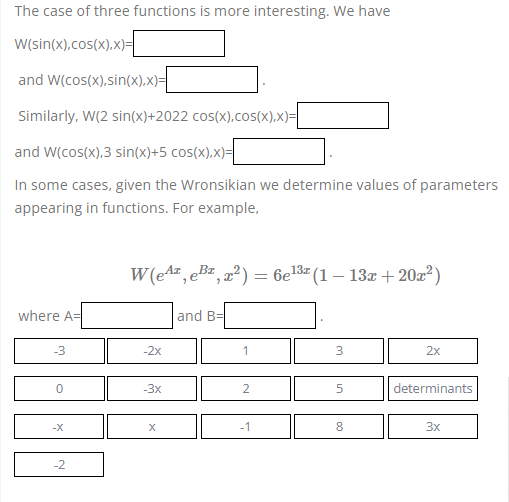The Wronskian of two differential functions f and g is W(f.g)=fg'-gf, more formally, f(x) W(f,g)(x) = det [F(2) g(2)] = f(x)g' (2) — 9(2)ƒ(z). More generally, the Wronsikian of three functions f,g, and h is defined as f(x) g(x) h(x) W(f, g, h)(x) = det f'(x) g'(x) h'(x) [f"(x) g"(x) h" (x)] For example, W(sin(x),cos(x))= This shows that the Wronskian can be constant. Further, we can use properties of to compute the Wronskian. For example, W(cos(x),sin(x))= W(2 sin(x)+2022 cos(x),cos(x))= and W(cos(x),3 sin(x)+5 cos(x))=
The Wronskian of two differential functions f and g is W(f.g)=fg'-gf, more formally, f(x) W(f,g)(x) = det [F(2) g(2)] = f(x)g' (2) — 9(2)ƒ(z). More generally, the Wronsikian of three functions f,g, and h is defined as f(x) g(x) h(x) W(f, g, h)(x) = det f'(x) g'(x) h'(x) [f"(x) g"(x) h" (x)] For example, W(sin(x),cos(x))= This shows that the Wronskian can be constant. Further, we can use properties of to compute the Wronskian. For example, W(cos(x),sin(x))= W(2 sin(x)+2022 cos(x),cos(x))= and W(cos(x),3 sin(x)+5 cos(x))=
Advanced Engineering Mathematics
10th Edition
ISBN:9780470458365
Author:Erwin Kreyszig
Publisher:Erwin Kreyszig
Chapter2: Second-order Linear Odes
Section: Chapter Questions
Problem 1RQ
Related questions
Question
![The Wronskian of two differential functions f and g is W(f.g)=fg'-gf, more formally,
f(x)
W(f,g)(x) = det
[F(2) g(2)] = f(x)g' (2) — 9(2)ƒ(z).
More generally, the Wronsikian of three functions f,g, and h is defined as
f(x) g(x)
h(x)
W(f, g, h)(x) = det f'(x) g'(x) h'(x)
[f"(x) g"(x) h" (x)]
For example,
W(sin(x),cos(x))=
This shows that the Wronskian can be constant. Further, we can use properties
of
to compute the Wronskian. For example,
W(cos(x),sin(x))=
W(2 sin(x)+2022 cos(x),cos(x))=
and W(cos(x),3 sin(x)+5 cos(x))=](/v2/_next/image?url=https%3A%2F%2Fcontent.bartleby.com%2Fqna-images%2Fquestion%2Fc12a3358-77cb-4e4c-8e25-68008f46381b%2F4a281726-2917-4f60-b47e-1ad3e752d044%2F3xxjjmi_processed.png&w=3840&q=75)
Transcribed Image Text:The Wronskian of two differential functions f and g is W(f.g)=fg'-gf, more formally,
f(x)
W(f,g)(x) = det
[F(2) g(2)] = f(x)g' (2) — 9(2)ƒ(z).
More generally, the Wronsikian of three functions f,g, and h is defined as
f(x) g(x)
h(x)
W(f, g, h)(x) = det f'(x) g'(x) h'(x)
[f"(x) g"(x) h" (x)]
For example,
W(sin(x),cos(x))=
This shows that the Wronskian can be constant. Further, we can use properties
of
to compute the Wronskian. For example,
W(cos(x),sin(x))=
W(2 sin(x)+2022 cos(x),cos(x))=
and W(cos(x),3 sin(x)+5 cos(x))=

Transcribed Image Text:The case of three functions is more interesting. We have
W(sin(x),cos(x),x)=
and W(cos(x), sin(x),x)=
Similarly, W(2 sin(x)+2022 cos(x),cos(x),x)=
and W(cos(x),3 sin(x)+5 cos(x),x)=
In some cases, given the Wronsikian we determine values of parameters
appearing in functions. For example,
13z
W(e¹¹, e³¹, x²) = 6e¹³ª (1 − 13x +20x²)
2
where A=
and B=
-3
-2x
3
2x
0
-3x
5
determinants
-X
X
8
3x
-2
2
-1
Expert Solution
This question has been solved!
Explore an expertly crafted, step-by-step solution for a thorough understanding of key concepts.
Step by step
Solved in 6 steps with 6 images

Recommended textbooks for you

Advanced Engineering Mathematics
Advanced Math
ISBN:
9780470458365
Author:
Erwin Kreyszig
Publisher:
Wiley, John & Sons, Incorporated

Numerical Methods for Engineers
Advanced Math
ISBN:
9780073397924
Author:
Steven C. Chapra Dr., Raymond P. Canale
Publisher:
McGraw-Hill Education

Introductory Mathematics for Engineering Applicat…
Advanced Math
ISBN:
9781118141809
Author:
Nathan Klingbeil
Publisher:
WILEY

Advanced Engineering Mathematics
Advanced Math
ISBN:
9780470458365
Author:
Erwin Kreyszig
Publisher:
Wiley, John & Sons, Incorporated

Numerical Methods for Engineers
Advanced Math
ISBN:
9780073397924
Author:
Steven C. Chapra Dr., Raymond P. Canale
Publisher:
McGraw-Hill Education

Introductory Mathematics for Engineering Applicat…
Advanced Math
ISBN:
9781118141809
Author:
Nathan Klingbeil
Publisher:
WILEY

Mathematics For Machine Technology
Advanced Math
ISBN:
9781337798310
Author:
Peterson, John.
Publisher:
Cengage Learning,

